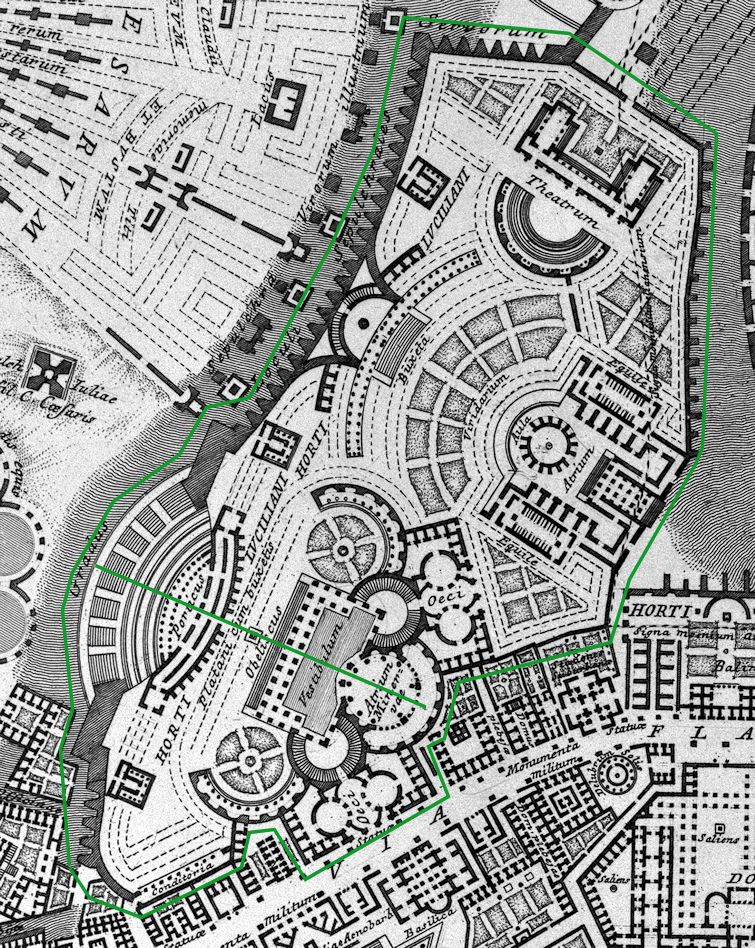Inside the Density of G. B. Piranesi's Ichnographia Campus Martius
satire 1 a : an ancient Roman commentary in verse on some prevailing vise of folly b : a usually topical literary composition holding up human or individual vices, folly, abuses, or shortcomings to censure by means of ridicule, derision, burlesque, irony, or other method sometimes with an intent to bring about improvement c : LAMPOON 2 a : a branch of literature ridiculing vice or folly
1. Piranesi's delineation of the Horti Luciliani is the Ichnographia's nexus of satire.
2. There was no Horti Luciliani in ancient Rome, however, C. Lucilius was the father of Roman satire.
3. There is a small theater at one end of the Horti Luciliani, which is perfectly appropriate.
4. The main focal point of the Horti Luciliani plan is the Atrium Minervae, an atrium in honor of Minerva, the Roman goddess of wisdom, of sense and reflection, of the arts and sciences, of poetry, and of spinning and weaving.
5. In terms of true geography, Piranesi's positioning of the Horti Luciliani is exactly where the Horti Lucullani actual was and indeed, on the Ichnographia, should be. Could it be that Piranesi is here playing a somewhat satirical word game?
6. Manfredo Tafuri exalts the Horti Luciliani in his The Sphere and the Labyrinth - Avant-Gardes and Architecture from Piranesi to the 1970s, when he states:
"But it is in the Horti Luciliani that the mechanical architecture of Piranesi reaches an extreme level of abstraction. Here, a complex of structures in semicircles and in sectors of circles obeys the rule of gemmation, as the revolve around the Atrium Minervae; an astonishing mechanism, in which Piranesi achieves the maximum refinement of his geometric instruments."
But then Tafuri immediately continues with:
"The overall result of this sample book of typological inventions excludes--the choice is deliberate--the characterization of the city as a completed formal structure. The clash of the organisms, immersed in a sea of formal fragments, dissolves even the remotest memory of the city as a place of Form.
If only Tafuri was here also being satirical, rather than displaying his Campo Marzio shortcomings.
7. The grand staircase leading up the Horti Luciliani aligns precisely with the Spanish Steps of Rome today.
8. Within a year of completing the Ichnographia Campi Martii, Piranesi moved his family and his business to a building along the street at the top of the Spanish Steps. One has to then wonder whether Piranesi already had the building he moved to in mind when he drew the Horti Luciliani. And I personally wonder just how close Piranesi's new residence comes to the Horti Luciliani's Atrium Minervae.
9. Wisdom and satire, what a metabolic combination!
| |

1. theater 2. the Atrium Minervae 3. the grand staircase leading to the Horti Luciliani
The green line traces the borders of the Horti Luciliani
| |
1999.12.12
(eighth of) Top 10
The ATOMIUM in Brussels, Belgium
This monument from 1958 has become the Eiffel Tower of Brussels. The Atomium is the visual representation of the concept of an "atom". It symbolizes an elementary iron crystal with its 9 atoms and magnified 150 billion times. It honored the metal and iron industry and the belief in the atomic power. The architect was André Waterkeyn. It took 18 months to conceive and another 18 months to construct. The monument is coated with aluminum, weighs 2,400 tons and is 102 meters high. Each sphere has a diameter of 18 meters. An elevator takes visitors to the upper sphere where one can enjoy a panoramic view of the Heysel area and (if the weather is good) the city of Brussels. There is also a good buffet-restaurant (Chez Adrienne) in the upper sphere. In the other spheres expositions are organized. They can be visited by means of escalators. In the coming years the monument will undergo cleaning and restoration.
On 26 November 1999 I had dinner in the very top 'atom' of the Atomium with various other participants of Inside Density (Mark Wigley, Winka Dubbeldam, Martine de Maeseneer, Charlotte Geldolf, Bernard Kormoss, Peter Zellner, Olivier Mathieu, Li Mei Tsien, Annemie Depuydt, Eric Van Daele, and Kai Vöckler to name most), and it was indeed a pleasure to spend one of my last meals of this century with a group of architects I've never met before within a reenactment of the iron crystal. And how about the 'scale' of that thing: 1 :: 150,000,000,000
|